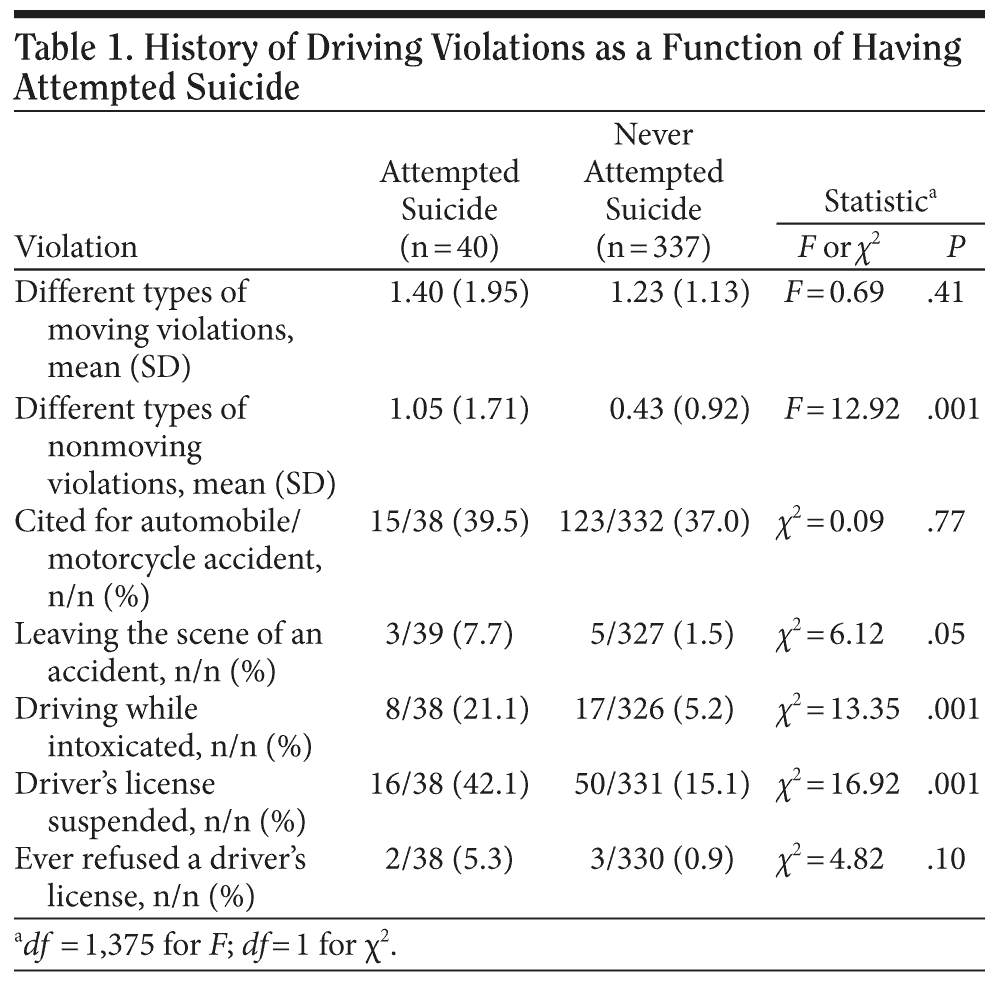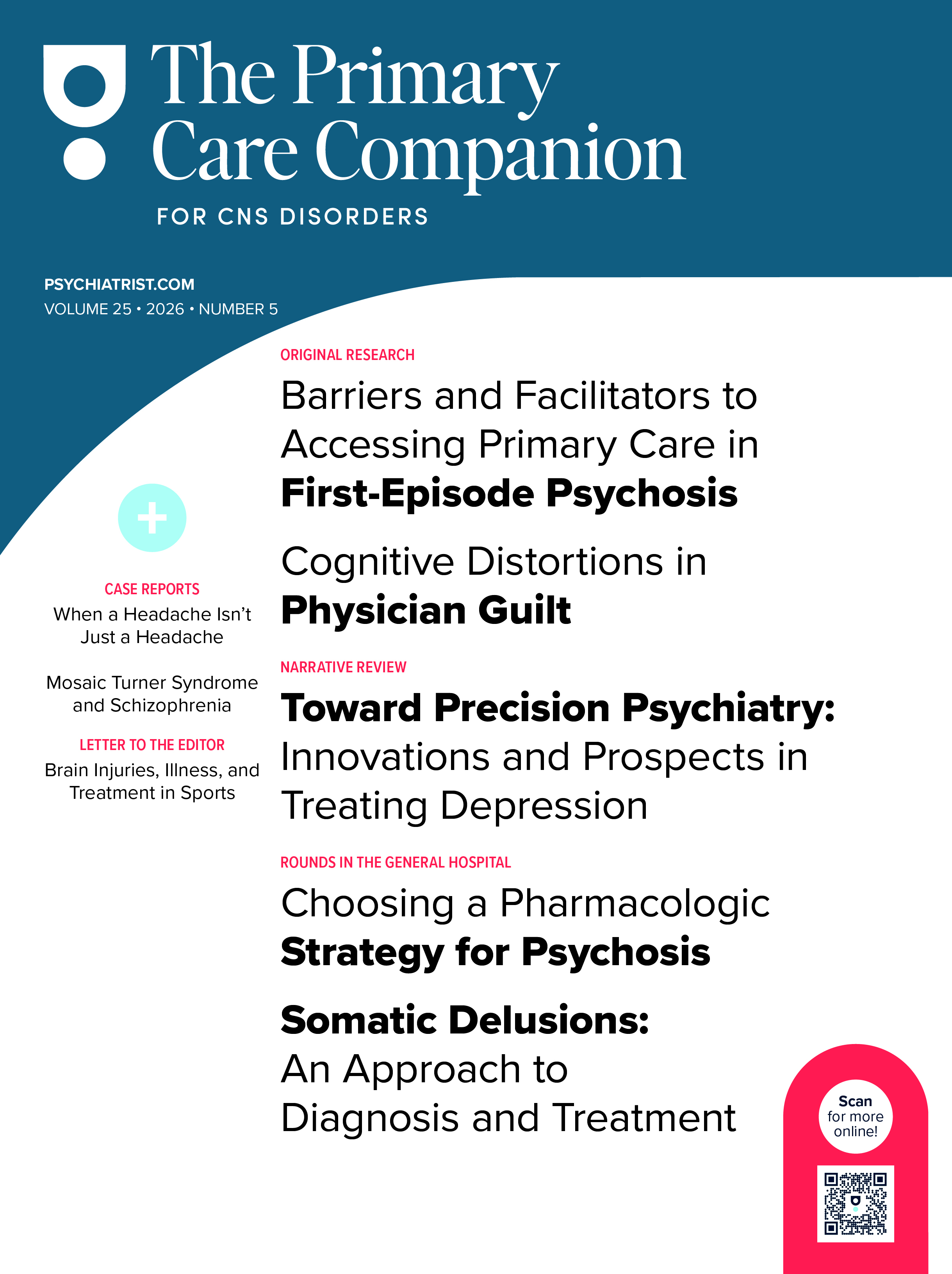History of Attempted Suicide and Reckless Driving: A Cross-Sectional Study in Primary Care
Objective: In this study, we explored whether a past history of suicide attempts is associated with a history of reckless driving (ie, driving citations).
Method: Using a cross-sectional design in a consecutive sample of primary care outpatients from a suburban setting in Ohio, we surveyed men and women (N = 419), aged 18-65 years, who were seeking nonemergent medical care during April 2009. With yes/no response options, we queried participants about whether they (1) had ever attempted suicide and (2) had tried to hurt or kill themselves. We also asked if they had ever been cited for any of 29 driving violations. After the elimination of participants who responded illogically to the 2 items exploring suicide attempts, the working sample was reduced to 377 participants.
Results: According to statistical analyses, compared to participants who did not acknowledge histories of suicide attempts (n = 337), participants who acknowledged histories of suicide attempts (n = 40) were no more likely to report a greater number of different types of moving violations or automobile/motorcycle accidents (ie, high-risk driving behaviors). However, participants with past suicide attempts reported a statistically significantly greater number of different types of nonmoving violations (P = .001) as well as being cited for leaving the scene of an accident (P = .05), driving while intoxicated (P = .001), and having a driver’s license revoked (P = .001) than those without past attempts.
Conclusions: While a past history of suicide attempts does not appear to overtly predict reckless driving behavior, there appear to be other associated and specific problematic driving behaviors.
Prim Care Companion J Clin Psychiatry 2010;12(4):e1-e4
© Copyright 2010 Physicians Postgraduate Press, Inc.
Submitted: September 14, 2009; accepted November 17, 2009.
Published online: August 5, 2010 (doi:10.4088/PCC.09m00888blu).
Corresponding author: Randy A. Sansone, MD, Sycamore Primary Care Center, 2115 Leiter Rd, Miamisburg, Ohio 45342 ([email protected]).
Suicide attempts or completions through automobile crashes are well described in the literature.1–4 Indeed, a number of empirical studies have addressed the percentage of fatal vehicular crashes that may be attributed to suicidal intent. For example, in a US sample, Schmidt and colleagues examined 182 driving fatalities and attributed 1.7% to suicide.5 In a Norwegian study, Morild found that 2.3% of 133 vehicular deaths were due to suicide.6 Ohberg and colleagues7 examined a Finnish sample (N = 1,419) and found that 7.0% of driver fatalities were possible suicides. These latter findings are akin to those of Hernetkoski and Keskinen,8 who determined a rate of 7.4%—similar to previous Finnish data. Finally, Alvestad and Haugen9 retrospectively studied 230 forensic reports of Norwegian drivers who were involved in fatal vehicular crashes and attributed 2.5% to suicide intent. In summary, according to US, Norwegian, and Finnish studies, existing data suggest that a small minority (1.7%-7.4%) of vehicular deaths are associated with suicide.
In contrast to studies of fatalities involving drivers, 2 studies have explored the suicide intent of survivors of vehicular crashes. In a 1973 Finnish study, Hamalainen10 found that the frequency of suicide attempts or plans was significantly higher in drunken drivers with serious or moderate-damage vehicular accidents (n = 40) compared to controls (n = 20), who had no accidents during the preceding 5 years. In contrast, in a 2006 Italian study, Pompili and colleagues11 found that there was no difference in the prevalence of suicidal ideation between drivers in single-car accidents (n = 30) and drivers with no accidents.
In the present cross-sectional study of a consecutive primary care sample in a suburban setting in a medium-sized city in Ohio, we examined whether self-reported histories of suicide attempts are associated with a history of being charged with driving citations, particularly driving behaviors related to reckless driving. We hypothesized that participants with histories of suicide attempts would have a greater frequency of moving violations and automobile/motorcycle accidents (ie, high-risk events).
METHOD
Participants
Participants included men and women being seen for nonemergent medical care in an outpatient primary care clinic, which is staffed by both faculty and residents from the Department of Internal Medicine, Kettering Medical Center, Kettering, Ohio. We excluded participants who might be unable to complete a survey—ie, those with compromising medical (eg, dementia, pain), intellectual (eg, mental retardation), or psychiatric disorders (eg, psychotic). A total of 492 people were invited to participate and 419 agreed, for a response rate of 85.2%.
Clinical Points
- In comparing those with versus those without a past history of suicide attempt, we found no statistically significant differences with regard to moving violations or automobile/motorcycle accidents, suggesting that drivers with such histories are not an overt danger to others.
- Individuals with histories of suicide attempt demonstrated more citations for nonmoving violations, leaving the scene of an accident, and driving while intoxicated, as well as having had their driver’s license revoked, suggesting some potentially hazardous behaviors related to driving a vehicle.
Of the 419 respondents, 130 were male, 287 were female, and 2 failed to indicate sex. Respondents ranged in age from 18 to 65 years (mean = 49.48, SD = 15.26). Most participants were white (358, 85.4%); 35 participants were black, 8 Native American, 2 Hispanic, 4 Asian, and 11 “other”; and 1 failed to indicate race/ethnicity. With regard to educational attainment, most (92.1%) had at least graduated high school, with 159 (37.9%) having attended some college and 110 (26.3%) having earned at least a 4-year college degree.
Procedure
During afternoon clinic hours, one of the authors (C.L.) positioned herself in the lobby of the outpatient clinic and approached incoming patients. After informal assessment for exclusion criteria, she reviewed with potential candidates the focus of the project and then invited each to participate. Each participant was asked to complete a 4-page survey, which took about 10 minutes, and to place the completed survey into a sealed envelope and then into a collection box in the lobby.
In the initial portion of the survey, we explored demographic information (ie, sex, age, marital status, racial/ethnic origin, educational level). We next explored whether participants had ever been charged with any of 29 legal citations related to driving infractions (charges, not convictions). With yes/no response options, we inquired about 12 moving violations (eg, speeding, reckless driving, going through a stop sign), 11 nonmoving violations (eg, expired registration, violating a muffler law, lack of proof of insurance), automobile/motorcycle accidents, driving while intoxicated, vehicular manslaughter, leaving the scene of an accident, and whether the participant had ever had his or her driving privileges suspended or been refused a driver’s license in any state. Finally, in one section of the booklet, we asked if the participant had ever attempted suicide (“Have you ever ‘ ¦ attempted suicide?”), and in another section, we asked if the participant had ever tried to hurt or kill herself/himself (“I have tried to hurt or kill myself.”).
Data were collected during April 2009. The project was approved by the institutional review boards of both the affiliated community hospital (Kettering Medical Center, Kettering, Ohio) as well as the university (Wright State University, Dayton, Ohio). Completion of the survey was assumed to be implied consent.
The data were analyzed using the Statistical Package for the Social Sciences, version 16.0 (SPSS Inc, Chicago, Illinois). We performed simple comparisons between the respondents with a history of attempted suicide and those respondents without such a history. For dependent variables measured on a continuous scale, group comparisons consisted of 1-way analyses of variance (ANOVAs). For categorical variables, group comparisons consisted of simple χ2 analyses with 1 degree of freedom.
RESULTS
A total of 381 respondents completed both suicide attempt items. Of these, 326 responded “no” to both suicide attempt items. Forty participants responded “yes” to both suicide attempt items. Interestingly, 11 respondents indicated “no” to the initial query (“Have you ever ‘ ¦ attempted suicide?”) but “yes” to the second query (“I have tried to hurt or kill myself.”). Because these may have been individuals who had attempted self-harm, but without suicidal intent, we included these individuals in the nonsuicidal group. Last, there were 4 respondents who indicated “yes” to the first query but “no” to the second query (an illogical pattern of response). These individuals were dropped from further analyses. In the end, we compared the 40 respondents who endorsed both suicide attempt items to the remaining 337 respondents.
The comparison of these 2 groups with regard to history of driving violations is presented in Table 1. No participant admitted to vehicular homicide, so this variable is not included in the table.
Note that compared to participants without histories of suicide attempts, those with histories of suicide attempts evidenced a statistically significantly greater number of different types of nonmoving violations as well as a greater likelihood of being charged with leaving the scene of an accident, driving while intoxicated, and having their driver’s license suspended (Table 1). In contrast, there were no statistically significant associations with the number of different types of moving violations or the likelihood of having been cited for an automobile/motorcycle accident or refused a driver’s license.
DISCUSSION
Contrary to our expectations, this cohort of primary care patients did not demonstrate any statistically significant relationships between a past history of suicide attempts and (1) the number of different types of citations for moving violations or (2) the number of automobile/motorcycle accidents. However, there were statistically significant relationships between those with a past history of suicide attempts and the number of different types of nonmoving violations, leaving the scene of an accident, being charged with driving while intoxicated, and having had a driver’s license suspended. Overall, these findings seem to suggest that a past history of suicide attempt does not heighten the probability of dangerousness to others (ie, moving violations, automobile/motorcycle accidents).
However, having affirmed the preceding, we note that suicide attempters were more likely to be charged with leaving the scene of an accident, driving while intoxicated, and having had their driver’s licenses revoked. This finding may simply suggest that those with histories of suicide attempts are more likely to demonstrate associations with alcohol/substance abuse, which is, in turn, associated with bad judgment (ie, leaving the scene of an accident) and the revocation of one’s driver’s license. In other words, substance abuse, rather than reckless driving, may be the key denominator with regard to carelessness about one’s own survival.
In our opinion, these data are not in conflict with either of the prior 2 studies that have examined suicidal intent and driving difficulties among survivors of automobile crashes. In relationship to the Hamalainen data,10 which found that suicide attempts or plans were significantly higher in the auto accident versus no accident groups, the cohorts are not seemingly comparable. Participants in the Hamalainen et al study10 were Finnish male drunk drivers (n = 40) with serious-to-moderate-damage vehicular accidents. In our study, there was no greater incidence of automobile or motorcycle accidents between those with versus those without a past suicide attempt. As for the Pompili et al study,11 which consisted of an Italian sample that had been hospitalized for an average of 10 days following a single-car accident, our data are similar in finding that suicide attempts did not differentiate between those with versus those without driving accidents.
We must underscore that the statistically significant relationships between a past history of suicide attempts and the relevant driving variables in this study are probably mediated by a number of adjunctive psychological factors. These factors might include mood and anxiety disorders, alcohol/substance misuse, and character pathology (eg, cluster B disorders). Only further research will tease out these mediating psychiatric possibilities.
This study has a number of potential limitations including the use of self-report data and the associated inherent limitations of this type of methodology, the use of an author-developed survey about driving citations (we were unable to locate a relevant study measure), and the confusing responses of a subgroup of participants who, in one section of the survey, admitted to a suicide attempt, but in another, denied it. However, this is a feasible sample size, the sample is consecutive in nature, the response rate is reasonable, and preceding studies in this area are scarce. Contrary to our suspicions, these data indicate that individuals with past histories of suicide attempts do not evidence a higher risk for different types of driving citations related to moving violations or automobile/motorcycle accidents. However, in comparison to those without suicide attempts, those with such attempts evidenced a statistically significantly greater number of different types of nonmoving violations as well as citations for leaving the scene of an accident and driving while intoxicated and history of revocation of one’s driver’s license. Clearly, further research needs to be undertaken to explore the relationships between driving impairment, suicide attempts, and alcohol/substance abuse.
Author affiliations: Department of Psychiatry and Internal Medicine (Dr Sansone) and School of Medicine (Ms Lam), Wright State University, Dayton, Ohio; Department of Psychiatry Education, Kettering Medical Center, Kettering, Ohio (Dr Sansone); and Department of Human Relations, Columbia College, Columbia, South Carolina (Dr Wiederman).
Potential conflicts of interest: The authors report no financial or other affiliations relevant to the subject of this article.
Funding/support: None reported.
REFERENCES
1. Grimmond BB. Suicide at the wheel. N Z Med J. 1974;80(521):90-94. PubMed
2. Imajo T. Suicide by motor vehicle. J Forensic Sci. 1983;28(1):83-89. PubMed
3. Brevig T, Arnestad M, M׸rland J, et al. Of what significance are diseases, intoxication and suicide in fatal traffic accidents? Tidsskr Nor Laegeforen. 2004;124(7):916-919. PubMed
4. Hourani LL, Davidson L, Clinton-Sherrod M, et al. Suicide prevention and community-level indictors. Eval Program Plann. 2006;29(4):377-385. PubMed doi:10.1016/j.evalprogplan.2006.08.001
5. Schmidt CW Jr, Shaffer JW, Zlotowitz HI, et al. Suicide by vehicular crash. Am J Psychiatry. 1977;134(2):175-178. PubMed
6. Morild I. Traffic deaths in western Norway: a study from the county of Hordaland 1986-1990. Forensic Sci Int. 1994;64(1):9-20. PubMed doi:10.1016/0379-0738(94)90238-0
7. Ohberg A, Penttila A, Lonnqvist J. Driver suicides. Br J Psychiatry. 1997;171(5):468-472. PubMed doi:10.1192/bjp.171.5.468
8. Hernetkoski K, Keskinen E. Self-destruction in Finnish motor traffic accidents in 1974-1992. Accid Anal Prev. 1998;30(5):697-704. PubMed doi:10.1016/S0001-4575(97)00092-4
9. Alvestad M, Haugen OA. Death behind the wheel. Tidsskr Nor Laegeforen. 1999;119(7):966-968. PubMed
10. Hamalainen K. Automobile accidents as self-destructive behavior: a study of the accidents of drinking-drivers. Psychiatr Fenn. 1973;147-151.
11. Pompili M, Girardi P, Tatarelli G, et al. Suicidal intent in single-car accident drivers: review and new preliminary findings. Crisis. 2006;27(2):92-99. PubMed



